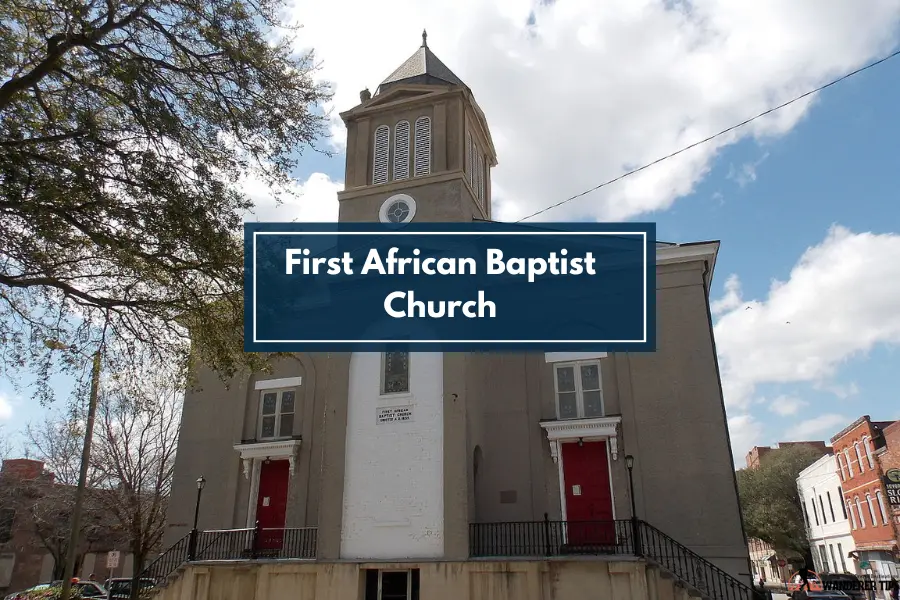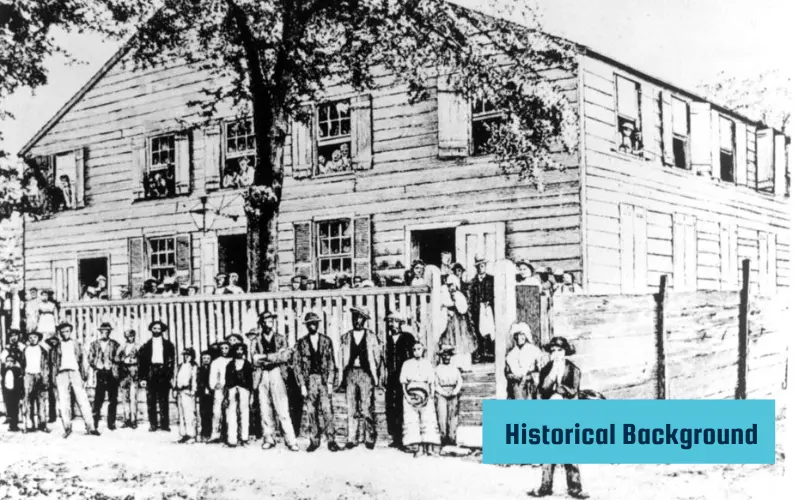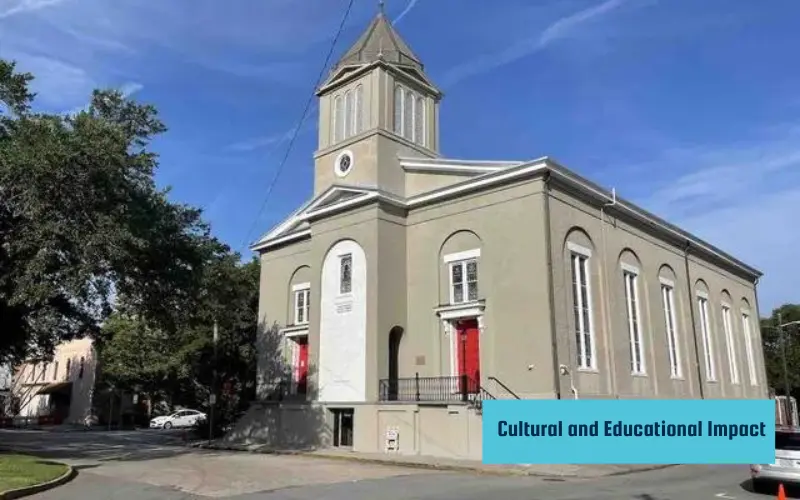First African Baptist Church [Savannah, GA 2024]

Embarking on a journey to explore the rich tapestry of African American heritage and religious history often leads us to seek monuments of enduring legacy and spiritual significance. This church isn’t just a building; it’s a living chronicle of the journey from slavery to freedom, a hub of community and civil rights activism, and a cradle of cultural heritage that inspires generations. By delving into its history, we don’t just promise to bridge the gap between past and present; we offer a vivid exploration of the soul of a community that fought for justice, equality, and recognition against all odds.
As we peel back the layers of its storied past, we uncover a narrative of struggle, triumph, and enduring hope. The First African Baptist Church doesn’t just tell a story; it invites us into a living, breathing legacy of a community’s fight for dignity and justice. Let’s embark on this journey together, where history and heritage converge to offer insights and inspiration from one of the nation’s most significant religious landmarks.
Introduction: First African Baptist Church
The First African Baptist Church, nestled within the historic heart of Savannah, Georgia, is more than just a place of worship; it’s a pivotal landmark in American history and culture landscape. Established in 1773, this church not only predates the founding of the United States but also stands as a testament to the resilience and enduring spirit of the African American community. Its significance transcends religious boundaries, embodying a rich tapestry of cultural heritage, social justice, and a relentless quest for freedom and equality. This church is not just a structure of bricks and mortar but a beacon of hope and a repository of the untold stories of countless souls who sought solace and solidarity within its hallowed walls.
| Feature | Details |
|---|---|
| Founded | 1773 by Rev. George Leile |
| Architectural Highlights | Original pews with West African Arabic script, stained-glass windows, ceiling design as a symbol of the Underground Railroad |
| Civil Rights Role | Leadership in revitalizing the NAACP’s Savannah chapter, a hub for civil rights activities |
| Cultural Impact | Contributions to education, involvement in the Underground Railroad, establishment of educational institutions |
| Visiting Information | Offers tours that explore the church’s historical, cultural, and architectural significance |
| Location | Savannah, Georgia, USA |
Historical Background
Founded by the Reverend George Leile, the First African Baptist Church is one of the earliest African American Baptist congregations in North America. Rev. Leile’s leadership marked the beginning of a profound legacy, as he laid the foundations of the church in 1773, even before the official birth of the United States. His pioneering spirit not only established a spiritual sanctuary for African Americans but also signaled the inception of the American Baptist missionary movement.
Under Leile’s guidance and later under the stewardship of other notable figures such as Andrew Bryan and Andrew Cox Marshall, the church evolved from a fledgling congregation into a cornerstone of community life and activism. Throughout its storied history, the First African Baptist Church has played a multifaceted role, serving as a vital meeting point for social and civil rights activism, a hub for educational advancement, and a symbol of the enduring faith and resilience of the African American community.
As we delve into the historical backdrop of the First African Baptist Church, we uncover a narrative woven with the threads of determination, struggle, and triumph. From its early days, predating the formal establishment of the United States, to its pivotal role in the civil rights movement, the church’s evolution mirrors the broader journey of African Americans toward freedom and equality. It stands as a living monument to the power of faith and community in adversity and a beacon of hope for future generations.

Architectural Significance
The First African Baptist Church is not just a place of worship; it’s an architectural marvel that tells a story of resilience, culture, and history. Unique features of the church include the original pews that carry inscriptions in West African Arabic script, a testament to the African heritage of the congregants who crafted them. These pews are among the earliest physical evidence of the enslaved Africans’ attempt to preserve their native culture and language in a foreign land.
The stained-glass windows also stand out, portraying African-American subjects in a manner that was groundbreaking for its time, challenging the racial norms of the era and celebrating black spiritual and physical presence. Additionally, the structure of the building itself holds significance. Its design, with a ceiling resembling the “Nine Patch Quilt,” hints at its role as a safe house for fugitive slaves, marking it as a beacon of hope and sanctuary. These architectural elements combine to make the church a living museum of African-American history, culture, and artistry.
Role in the Community and Civil Rights Movement
Under the dynamic leadership of Reverend Ralph Mark Gilbert in the 1940s, the First African Baptist Church became a pivotal center in the fight for civil rights, notably rejuvenating the NAACP’s Savannah chapter. Gilbert’s tenure marked the church as a focal point for organizing and mobilizing the African American community against segregation and injustice. The church’s open doors to both black and white communities during a time of enforced segregation symbolized unity and resilience, serving as a venue for dialogue, planning, and protest that bridged racial divides. Its walls have heard speeches from civil rights leaders and seen the congregation rally for equal rights, making it an indispensable part of the movement’s history in Savannah and beyond.
Cultural and Educational Impact
The First African Baptist Church has played a significant role in the education and upliftment of African Americans. It helped establish educational institutions, contributing significantly to the literacy and academic status of the black community in Savannah and surrounding areas. This initiative reflects the church’s broader mission to empower its congregation and the African American community, extending beyond spiritual guidance to educational advancement. Furthermore, the church’s involvement in the Underground Railroad highlights its critical place in the struggle against slavery. Serving as a secret pathway to freedom symbolized hope and resistance, a testament to the church’s commitment to justice and equality.

Visiting Today
Today, First African Baptist Church visitors can expect a journey through time, where every corner of the building and artifact tells a story of struggle, perseverance, and triumph. Tours offer an immersive experience of the church’s historical, architectural, and cultural significance. Visitors can learn about the church’s founding, its pivotal role in the civil rights movement, and its ongoing mission within the community.
The visiting hours are designed to accommodate both the curious tourist and the earnest scholar, providing a comprehensive view of the church’s impact on American history and African American culture. Through these tours, the First African Baptist Church continues to educate and inspire, ensuring that the stories of courage and resilience it embodies are passed on to future generations.
Conclusion
The First African Baptist Church is not just a cornerstone of African American history; it’s a testament to the enduring spirit of resilience, unity, and faith. From its inception in 1773 by Rev. George Leile, well before the official formation of the United States, to its pivotal role in the civil rights movement under the leadership of figures like Rev. Ralph Mark Gilbert, this church has been a beacon of hope and a site of monumental historical and cultural significance. Its unique architectural features, including pews with West African Arabic script and stained-glass windows depicting African-American subjects, vividly remind the congregation’s rich heritage and the broader American cultural tapestry.
Moreover, the church’s active involvement in community upliftment and education and its historical role in the Underground Railroad underscores its profound impact on the fight for justice and equality. Today, visitors can experience the profound legacy of the First African Baptist Church through tours that offer insight into its architectural, historical, and cultural significance, ensuring that the stories of courage and perseverance it embodies are preserved for future generations.
As we reflect on the church’s indelible mark on history, we are reminded of the power of faith and community in overcoming adversity. Let this article inspire you to visit the First African Baptist Church to witness firsthand the legacy of a community that has fought tirelessly for dignity, equality, and recognition. Embrace the opportunity to be part of a living history that celebrates the strength of the human spirit against all odds.

![One Day in New York [Ultimate Local’s Guide 2024]](https://wanderertips.com/wp-content/uploads/2024/03/One-Day-in-New-York-768x512.webp)

![Why Do Irish Travellers Dress Provocatively [6 Main Reasons]](https://wanderertips.com/wp-content/uploads/2024/04/why-do-Irish-Travellers-dress-provocatively-768x512.webp)
![Things To Do In Northwest Arkansas [6 amazing ways]](https://wanderertips.com/wp-content/uploads/2024/04/Things-To-Do-In-Northwest-Arkansas-768x512.webp)
![Palm Springs Downtown [10 Amazing Spots to check out]](https://wanderertips.com/wp-content/uploads/2024/03/palm-springs-downtown-768x512.webp)
![What Is Vermont Known For [Top 10 best things]](https://wanderertips.com/wp-content/uploads/2024/03/What-Is-Vermont-Known-For-768x512.webp)